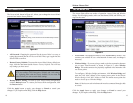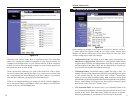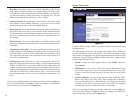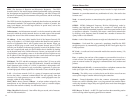
Wireless-G Access Point
What is WEP?
WEP is Wired Equivalent Privacy, a data privacy mechanism based on a 40-bit
shared-key algorithm, as described in the IEEE 802.11 standard.
What is a MAC Address?
The Media Access Control (MAC) address is a unique number assigned by the
manufacturer to any Ethernet networking device, such as a network adapter,
that allows the network to identify it at the hardware level. For all practical pur-
poses, this number is usually permanent. Unlike IP addresses, which can
change every time a computer logs on to the network, the MAC address of a
device stays the same, making it a valuable identifier for the network.
How do I avoid interference?
Using multiple Access Points on the same channel and in close proximity to
one another will generate interference. When employing multiple Access
Points, be sure to operate each one on a different channel (frequency).
How do I reset the Access Point?
Press the Reset button on the back of the Access Point for about ten seconds.
This will reset the unit to its default settings.
How do I resolve issues with signal loss?
There is no way to know the exact range of your wireless network without test-
ing. Every obstacle placed between an Access Point and wireless PC will cre-
ate signal loss. Leaded glass, metal, concrete floors, water and walls will inhib-
it the signal and reduce range. Start with your Access Point and your wireless
PC in the same room and move it away in small increments to determine the
maximum range in your environment.
You may also try using different channels, as this may eliminate interference
affecting only one channel. Also, due to FCC regulations, more power may be
transmitted, using 802.11a, on channels 52, 56, 60 and 64, than on the lower
channels. Lastly, check the Advanced tab of the Web-Based Utility and make
sure that FULL is selected in the Transmission Rate field.
Does the Access Point function as a firewall?
No. The Access Point is only a bridge from wired Ethernet to wireless clients.
I have excellent signal strength, but I cannot see my network.
WEP is probably enabled on the Access Point, but not on your wireless adapter
(or vice versa). Verify that the same WEP Keys and levels (64 or 128 ) are
being used on all nodes on your wireless network.
33
worldwide. This presents a truly revolutionary opportunity to place convenient
high speed wireless capabilities in the hands of users around the globe.
What is Spread Spectrum?
Spread Spectrum technology is a wideband radio frequency technique devel-
oped by the military for use in reliable, secure, mission-critical communica-
tions systems. It is designed to trade off bandwidth efficiency for reliability,
integrity, and security. In other words, more bandwidth is consumed than in the
case of narrowband transmission, but the trade-off produces a signal that is, in
effect, louder and thus easier to detect, provided that the receiver knows the
parameters of the spread-spectrum signal being broadcast. If a receiver is not
tuned to the right frequency, a spread-spectrum signal looks like background
noise. There are two main alternatives, Direct Sequence Spread Spectrum
(DSSS) and Frequency Hopping Spread Spectrum (FHSS).
What is DSSS? What is FHSS? And what are their differences?
Frequency Hopping Spread Spectrum (FHSS) uses a narrowband carrier that
changes frequency in a pattern that is known to both transmitter and receiver.
Properly synchronized, the net effect is to maintain a single logical channel. To
an unintended receiver, FHSS appears to be short-duration impulse noise.
Direct Sequence Spread Spectrum (DSSS) generates a redundant bit pattern for
each bit to be transmitted. This bit pattern is called a chip (or chipping code).
The longer the chip, the greater the probability that the original data can be
recovered. Even if one or more bits in the chip are damaged during transmis-
sion, statistical techniques embedded in the radio can recover the original data
without the need for retransmission. To an unintended receiver, DSSS appears
as low power wideband noise and is rejected (ignored) by most narrowband
receivers.
Would the information be intercepted while transmitting on air?
WLAN features two-fold protection in security. On the hardware side, as with
Direct Sequence Spread Spectrum technology, it has the inherent security fea-
ture of scrambling. On the software side, the WLAN series offers the encryp-
tion function (WEP) to enhance security and access control. Users can set it up
depending upon their needs.
Can Instant Wireless
TM
products support file and printer sharing?
Instant Wireless
TM
products perform the same function as LAN products.
Therefore, Instant Wireless
TM
products can work with Netware, Windows
NT/2000, or other LAN operating systems to support printer or file sharing.
32


















